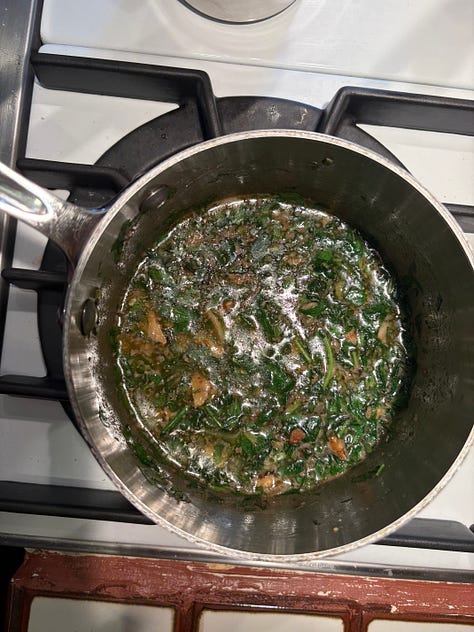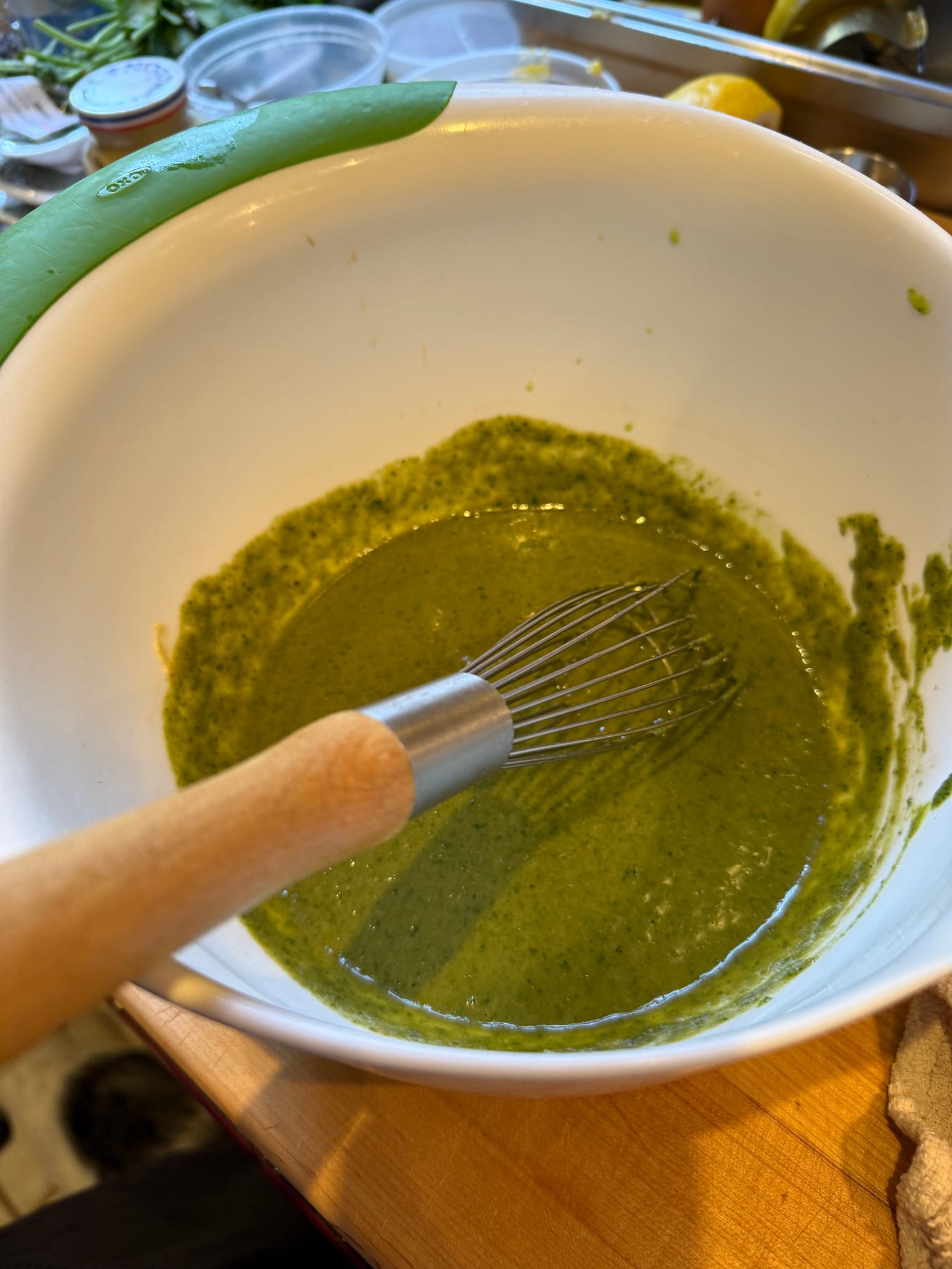on l'entrecôte sauce.
or that sweet, sweet sauce that goes with steak frites and everything else.
I wanted to time this to the French Open. Serve it with a side of clay dust and Roland-Garros sun.
But, life (as it many times tends to do) had other plans.
So instead, you’re getting a slightly delayed, albeit tried and tested sauce.
Damn good sauce, may I say.
This one owes its name to the Parisian institution L’Entrecôte — a place that built a cult following on three things: sirloin steak, pommes frites, and a greenish mystery sauce that’s been haunting chefs around the world for decades.
It’s that kind of perfect accompaniment that doesn’t hog the spotlight — it sets the stage. It’s a sauce that cuts the fat, kisses the meat, clings to the fry like it’s in on the secret.
It’s a beaut.
And look, I know I’m not the first to take a stab at it.
The internet’s full of guesses, tributes, and near-misses.
Most of them? Solid. Respectable, even.1
So why toss my hat in the ring?
Because when your sister-in-law’s scraping the last of the sauce from the bowl with a fork — long after the steak and fries are gone — you start to think: maybe you’ve got something worth writing down.
So here it is. My take on the cult classic.
No secrets.
No gatekeeping.
And since you’ll need something to put it on, I’m throwing in a few thoughts on how to cook a steak that actually deserves the sauce.
Because, who eats just sauce? (Only respect, Sophie.)
Bon appétit!
how to make + enjoy it.
Serves: 2 (Serve Warm)
Prep Time:
Sauce: 15–20 minutes
Steak: 30–35 minutes active (plus 1 day for dry brining)
Cook Time:
Sauce: 15–20 minutes
Steak: ~15 minutes total cook time (sear, baste, oven) + 10 minutes rest
ingredients.



For the Sauce:
1 bunch parsley
1 bunch basil
2 tbsp tarragon
2 fresh sage leaves
1 shallot, finely chopped or brunoised
6–7 walnuts
250g (about 2 sticks) unsalted butter, cubed
5 capers
5–6 anchovy fillets (tinned is fine!)
1 lemon
1 tsp Worcestershire sauce
1 tsp Dijon mustard
2 egg yolks
1 tsp Tabasco sauce
Salt, to taste
Freshly ground black pepper, to taste
For the Steak:
1 USDA Prime New York Strip Steak (about 1½–2 inches thick)
Kosher salt, for dry brining and seasoning
Flaky sea salt, for serving
Freshly ground black pepper, to taste
Neutral oil (vegetable, canola, or avocado), for searing
2–3 garlic cloves, smashed
2–3 sprigs fresh rosemary
2–3 sprigs fresh thyme
2–3 tbsp unsalted butter
instructions for the sauce.
Chop the Aromatics:
Finely chop the walnuts, capers, anchovies, parsley, tarragon, basil, and sage. Set aside.
Brown the Butter:
In a saucepan over medium heat, brown half the butter until golden and nutty (it should smell like popcorn). Add the shallots and 1 tsp of freshly ground black pepper. Cook until the shallots are soft but not browned.
Build the Base:
Add the remaining butter to the pan, followed by the chopped herb and anchovy mixture. Stir constantly to incorporate without cooking the herbs. Add a pinch of nutmeg and, if desired, a bit of lemon zest.
Blend:
Once the butter is fully melted and everything is combined, blend the mixture using an immersion blender (or traditional blender) until very fine. Set aside to cool slightly.
Emulsify the Sauce:
In a large bowl, whisk together the egg yolks, Worcestershire sauce, Tabasco, lemon juice, and mustard. While whisking constantly, slowly drizzle in the warm herb butter mixture to create an emulsified sauce.
Taste and Adjust:
Once the sauce reaches a mayonnaise-like consistency, taste and adjust seasoning as needed.
(Optional) Heat for Service:
You can set aside 1/3 of the sauce to retain its brightness. When ready to serve, gently warm the remaining 2/3 over low heat, then fold in the reserved portion to balance temperature and texture.
Serve:
Ideally over a medium-rare steak and a mountain of frites. But truthfully? This sauce plays well with most proteins — think roast chicken, poached white fish, even spooned over grilled vegetables.
(bonus) instructions for a *medium rare* steak.

Let’s get this out of the way: there’s more than one way to cook a cow (sorry for the image). And I’m not here to stand on ceremony.
Like I said above, this sauce doesn’t play favorites — it’ll play nicely with whatever cut you’ve got, however you like to cook it. Grill, sous vide, reverse sear, caveman-style on the coals — we can debate the details later.
For now, I’m giving you the method I trust most: a USDA Prime New York Strip, pan-seared (and basted), finished in the oven, and cooked to a dead-center medium rare (130–135°F internal).
Simple. Repeatable. Worthy of the sauce.
Start with the Brine:
Generously salt both sides of your steak and leave it uncovered in the fridge overnight. This dry brine builds flavor and pulls moisture to the surface for that deep, golden crust.
Let It Come to Temp:
At least 30–35 minutes before cooking, take the steak out of the fridge to let it come to room temperature. While you wait, gather your aromatics — garlic, rosemary, thyme — and a knob or two of butter.
Preheat the Oven:
Set your oven to 350°F (about 175°C). This will help finish the steak gently after searing.
Heat the Pan:
Place a carbon steel (or cast iron) skillet over medium-high heat. Let it get hot. Add a splash of neutral oil (vegetable, canola, etc.) to coat the bottom.
Season and Sear:
Just before the steak hits the pan, season both sides with fresh black pepper and (if needed) another light hit of salt. Place the steak in the pan, laying it away from you. Don’t touch it. Don’t move it. Let the crust happen. (Optional: weigh it down with another pan or press for maximum contact.)
Flip and Build the Crust:
Flip the steak every 90 seconds, building a rich, even crust. This should take about 3–4 minutes total.
Baste with Aromatics:
Add your butter and aromatics to the pan. Tilt the pan and baste the steak continuously for 60–90 seconds.2 This is where the flavor magic happens.
Finish in the Oven:
Transfer the pan to the oven and cook for another 4–5 minutes, or until the internal temp hits 130–135°F for medium rare. (Also, I cannot stress this enough — check the internal temp. It’s the best way to ensure the steak is the temperature you want it. No touch test. No smell test. Temperature probe to the thickest part of the steak, et voilà.)3
Rest:
Move the steak to a wire rack or cutting board. Let it rest, untouched, for 10 minutes. No shortcuts here — the rest is what keeps the juices in.
Slice and Serve:
Slice against the grain. Hit it with a final pinch of flaky salt if you’re feeling generous. Spoon over that warm L’Entrecôte sauce and serve.
notes + pairings.
Wine:
You’re already making the sauce — go all in and uncork something worthy. L’Oratoire des Papes Châteauneuf-du-Pape 2021 is a near-perfect match: full-bodied, herbaceous, with enough grip to stand up to the steak and enough complexity to echo the sauce’s anchovy-walnut-umami witchcraft. You’ll get dark fruit, spice, and a whisper of southern French wildness that plays like a duet with the aromatics in your pan.
If you’re branching out: a quirky Bordeaux or a bold Syrah works too. Cool Beaujolais if you’re aiming for unexpected-but-right.
Frites:
If you make ‘em, keep ’em crispy — ideally hand-cut and double-fried. Salted while hot. No truffle oil or extra seasoning. This is not that kind of meal.
Salad:
Bitter greens, vinaigrette sharp enough to wake the palate. Think frisée, radicchio, endive. Bonus points for shaved fennel or citrus supremes. Your arteries will thank you (eventually). I may just have the perfect recipe for ya.
Bread:
A crusty baguette or sourdough loaf — perfect for dragging through leftover sauce when the steak’s long gone.
Dessert:
Lemon tart, olive oil cake, or literally anything that doesn’t require a water bath. You’ve already done enough. Just keep it light. Or don’t. No judgment.
Music:
Think bistro, but skip the clichés. LCD Soundsystem. Rush. Hermanos Gutiérrez. The Grateful Dead. Or just throw on Travis Scott and let the bass rattle the butter off the counter. No rules. Just good vibes.
Especially, the recipe that I used as my baseline, from my ride or dies: the gents from Fallow.
You don’t need a fancy meat thermometer, but my go-to is the Thermapen (not sponsored). Also, here’s a handy guide for steak cooking temperatures.




